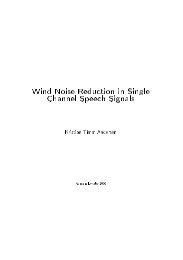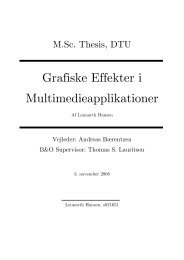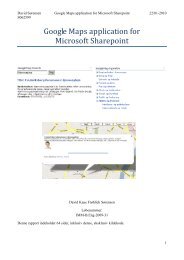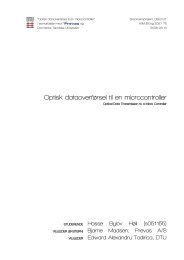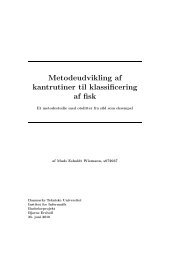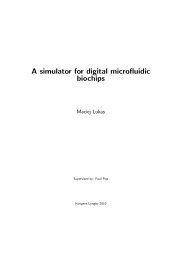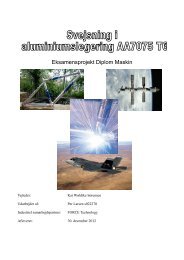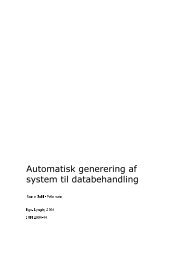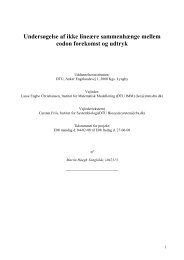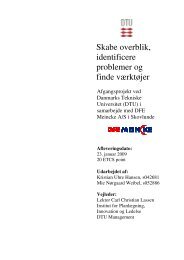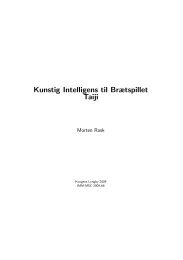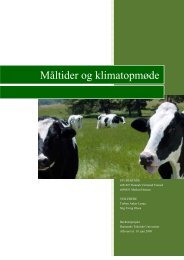- Page 1 and 2:
Design og modellering af metanolanl
- Page 3 and 4:
2 Resumé I forbindelse med DONG En
- Page 5 and 6:
4 Indholdsfortegnelse 1 Abstract...
- Page 7 and 8:
5 Indledning Baggrunden for dette p
- Page 9 and 10:
7 Design og statisk modellering af
- Page 11 and 12:
Brint er specielt fordelagtig til m
- Page 13 and 14:
Ligning 7.1: Den specifikke varmeka
- Page 15 and 16:
DNA-navn: DRYER_04 Forgasser Forgas
- Page 17 and 18:
T Fordampning Pinch points Figur 7.
- Page 19 and 20:
Massestrøm af Metanol/vand-blandin
- Page 21 and 22:
Parameter Værdi Komponenter Evt. k
- Page 23 and 24:
7.2 Anlægskonfigurationer Den opby
- Page 25 and 26:
7.3 Økonomi For at kunne vurdere o
- Page 27 and 28:
Input-priser Kilde Elektricitet 18
- Page 29 and 30:
7.4 Termoøkonomisk analyse Der er
- Page 31 and 32:
Komponent Produkt(er) Spild Elektro
- Page 33 and 34:
Tabet i fysisk exergi forekommer ho
- Page 35 and 36:
Anlæg 1 Total: 320 MWex (292 MW) 7
- Page 37 and 38:
antagelse, da naturgasnettet er try
- Page 39 and 40:
246 562 112 Anlæg 1 Total: 1222 mi
- Page 41 and 42:
Brændsel Pris Kilde [kr/L] [kr/GJe
- Page 43 and 44:
Metanolomkostning [kr/GJex] 500 450
- Page 45 and 46:
7.5.2 Parametervariation Nedenfor e
- Page 47 and 48:
Udkondenseret metanol [%] 100 95 90
- Page 49 and 50:
Metanolrenhed efter destillation [m
- Page 51 and 52:
vandkoncentrationen i syngassen fal
- Page 53 and 54:
Metanolexergivirkningsgrad [%] 73 7
- Page 55 and 56:
Metanolrenhed efter destillation [m
- Page 57 and 58:
Dette betyder at den metanolholdige
- Page 59 and 60:
Atmosfærisk forgasning (1 bar) Try
- Page 61 and 62:
7.6 Diskussion I parametervariation
- Page 63 and 64:
7.6.2 Alternative anlægsdesign Ned
- Page 65 and 66:
8 Benyttelse af underjordiske gasla
- Page 67 and 68:
8.2 Scenarier Der er undersøgt 2 s
- Page 69 and 70:
Ligning 8.5: Reference-el-omkostnin
- Page 71 and 72:
Ligning 8.13: Tidskonstant for lage
- Page 73 and 74:
Brintlagerbeholdning [MWh] 3000 250
- Page 75 and 76:
Brintlagerbeholdning [MWh] 400 350
- Page 77 and 78:
den time, hvor regulatorligningen b
- Page 79 and 80:
El-pris-funktionen [kr/MWh] 500 450
- Page 81 and 82:
Brintlagerbeholdning [MWh] 100 90 8
- Page 83 and 84:
Omkostninger [%] 100 90 80 70 60 50
- Page 85 and 86:
Sparede omkostninger [%] 30 25 20 1
- Page 87 and 88:
selvstændig investering og de omko
- Page 89 and 90: Tilbagebetalingstid (beregnet ud fr
- Page 91 and 92: Sparede omkostninger i nutidsværdi
- Page 93 and 94: Tilbagebetalingstid [år] 15 10 5 0
- Page 95 and 96: 8.4 Diskussion Resultaterne præsen
- Page 97 and 98: El-pris [kr/Mwh] 400 350 300 250 20
- Page 99 and 100: 9 Konklusion I den første del af r
- Page 101 and 102: http://www.energyserver.net/ET1/Def
- Page 103 and 104: 11 Nomenklaturliste c omkostning pe
- Page 105 and 106: Design og modellering af metanolanl
- Page 107 and 108: 25. Flowsheets for metanolanlæg -
- Page 109 and 110: 2. Forgasserpris - Choren Choren In
- Page 111 and 112: 4. El-afgifter og -tariffer GE-NET
- Page 113 and 114: 6. Naturgasafgifter - DONG Energy N
- Page 115 and 116: 8. Benzinforbrug til vejtransport E
- Page 117 and 118: 10. Benzinafgift Benzinafgifter fra
- Page 119 and 120: 12. Metanolpris Metanolpriser fra M
- Page 121 and 122: Methanex Non-Discounted Reference P
- Page 127 and 128: 14. Metanolproduktion, NZIC New Zea
- Page 129 and 130: Maui Gas Supply Kapuni Gas Supply N
- Page 131 and 132: Gas metering and letdown The proces
- Page 133 and 134: Methanol Distillation Crude methano
- Page 135 and 136: Product Gasoline Pipeline (250 mm N
- Page 137 and 138: steam, preheat the reactants (steam
- Page 139: As it is very difficult to separate
- Page 143 and 144: The reaction of the synthesis gas c
- Page 145 and 146: Figure 15 - Flowsheet of the MTG pr
- Page 147 and 148: 15. Metanolproduktion, Nykomb Nykom
- Page 149 and 150: NYKOMB SYNERGETICS 2. Methanol Plan
- Page 151 and 152: NYKOMB SYNERGETICS 6. Investment Es
- Page 153 and 154: NYKOMB SYNERGETICS 9. Logistics and
- Page 155 and 156: 16. Metanolproduktion, Wikipedia Wi
- Page 157 and 158: 18. Flowsheet for et metanolanlæg
- Page 159 and 160: 20. Flowsheet for metanolanlæg - u
- Page 161 and 162: 21. Flowsheet for metanolanlæg - t
- Page 163 and 164: 22. Flowsheet for metanolanlæg - t
- Page 165 and 166: 23. Flowsheets for metanolanlæg -
- Page 167 and 168: 0 1 1 1 P 2 M type NOD* 2 1 type NO
- Page 169 and 170: 0 1 1 1 P 2 M type NOD* 9 2 type NO
- Page 171 and 172: 24. Flowsheets for metanolanlæg -
- Page 173 and 174: 0 1 1 1 P 2 M type NOD* 1 1 type NO
- Page 175 and 176: 0 1 1 1 P 2 M type NOD* 1 1 type NO
- Page 177 and 178: 0 1 1 1 P 2 M type NOD* 1 1 type NO
- Page 179 and 180: 0 1 1 1 P 2 M type NOD* 1 1 type NO
- Page 181 and 182: 0 1 1 1 P 2 M type NOD* 1 1 type NO
- Page 183 and 184: 0 1 1 1 P 2 M type NOD* 1 1 type NO
- Page 185 and 186: 27. Flowsheet for metanolanlæg - f
- Page 187 and 188: 28. Flowsheet for metanolanlæg - f
- Page 189 and 190: 29. Matlab-kode til Scenarie 1
- Page 191 and 192:
18-03-07 23:10 D:\DTU\Eksamensproje
- Page 193 and 194:
18-03-07 23:10 D:\DTU\Eksamensproje
- Page 195 and 196:
18-03-07 23:10 D:\DTU\Eksamensproje
- Page 197 and 198:
18-03-07 23:10 D:\DTU\Eksamensproje
- Page 199 and 200:
18-03-07 23:10 D:\DTU\Eksamensproje
- Page 201 and 202:
18-03-07 23:10 D:\DTU\Eksamensproje
- Page 203 and 204:
19-03-07 19:26 D:\DTU\Eksamensproje
- Page 205 and 206:
19-03-07 19:26 D:\DTU\Eksamensproje
- Page 207 and 208:
19-03-07 19:26 D:\DTU\Eksamensproje
- Page 209 and 210:
Sparede omkostninger i nutidsværdi
- Page 211 and 212:
Sparede omkostninger i nutidsværdi
- Page 213 and 214:
32. DNA-kode for metanolanlæg
- Page 215 and 216:
metanolanlaeg.dna d:/DTU/Eksamenspr
- Page 217 and 218:
metanolanlaeg.dna d:/DTU/Eksamenspr
- Page 219 and 220:
33. Dokumentation for tilføjede DN
- Page 221 and 222:
17.121.4 Conditions ˙m1 > 0 ˙m2 <
- Page 223 and 224:
9. - 10. - 11. - 12. - 13. - 14. -
- Page 225 and 226:
17.123 GASIFI_3_VENZIN Gasifier wit
- Page 227 and 228:
13. - 14. - 15. - 16. - 17. - 18. -
- Page 229 and 230:
17.124 GASCLE_2 Syngas cleaning. Th
- Page 231 and 232:
38. Compound number 39. Compound nu
- Page 233 and 234:
43. - 44. - 45. - 46. - 47. - 48. -
- Page 235 and 236:
17.124.5 Example struc Cleaner GASC
- Page 237 and 238:
10. - 11. - 12. - 13. - 17.125.4 Co
- Page 239 and 240:
7. - 8. - 9. - 10. - 11. - 12. - 13
- Page 241 and 242:
17.126.4 Conditions ˙m1 > 0 ˙m2 <
- Page 243 and 244:
11. - 12. - 13. - 14. - 15. - 16. -
- Page 245 and 246:
17.128 SET_M Utility component for
- Page 247 and 248:
4. - 5. - 6. - 7. - 8. - 9. - 10. -
- Page 249 and 250:
17.129.4 Conditions ˙m1 > 0 ˙m2 <
- Page 251 and 252:
17.130.4 Conditions ˙m1 > 0 ˙m2 <
- Page 253 and 254:
17.131.2 Equations Number of equati
- Page 255 and 256:
17.132 EL-MOTOR Motor with efficien
- Page 257 and 258:
8. - 9. - 17.133.3 Conditions ˙m1
- Page 259 and 260:
17.135 MIXER_03 Mixer for ideal gas
- Page 261 and 262:
33. - 34. - 35. - 36. - 37. - 38. -
- Page 263 and 264:
17.137 SET_X Utility component for
- Page 265 and 266:
17.138.4 Conditions ˙m1 > 0 ˙m2 <
- Page 267 and 268:
17.140 SET_FLOW Utillity component
- Page 269 and 270:
17.142 SET_TEMP2 Utillity component
- Page 271 and 272:
34. Tilføjede komponenter til DNA
- Page 273 and 274:
VEnzin.for c:/dna/source/ C C Param
- Page 275 and 276:
VEnzin.for c:/dna/source/ CA ANTED
- Page 277 and 278:
VEnzin.for c:/dna/source/ IF (MDOT(
- Page 279 and 280:
VEnzin.for c:/dna/source/ MMVAR(1)
- Page 281 and 282:
VEnzin.for c:/dna/source/ ENDDO DO
- Page 283 and 284:
VEnzin.for c:/dna/source/ $fluid O2
- Page 285 and 286:
VEnzin.for c:/dna/source/ C−−
- Page 287 and 288:
VEnzin.for c:/dna/source/ CA FKOMP
- Page 289 and 290:
VEnzin.for c:/dna/source/ ENDDO NIN
- Page 291 and 292:
VEnzin.for c:/dna/source/ C Subrout
- Page 293 and 294:
VEnzin.for c:/dna/source/ CALL STAT
- Page 295 and 296:
VEnzin.for c:/dna/source/ CA 3: Flu
- Page 297 and 298:
VEnzin.for c:/dna/source/ C C C M_B
- Page 299 and 300:
VEnzin.for c:/dna/source/ C C SETFL
- Page 301 and 302:
VEnzin.for c:/dna/source/ C C GASCO
- Page 303 and 304:
VEnzin.for c:/dna/source/ RES(5) =
- Page 305 and 306:
VEnzin.for c:/dna/source/ c c c E2=
- Page 307 and 308:
VEnzin.for c:/dna/source/ C C HEATE
- Page 309 and 310:
VEnzin.for c:/dna/source/ $ ’$\\d
- Page 311 and 312:
VEnzin.for c:/dna/source/ c 1 = Wat
- Page 313 and 314:
VEnzin.for c:/dna/source/ CA 4: Fin
- Page 315 and 316:
VEnzin.for c:/dna/source/ CL K_MED
- Page 317 and 318:
VEnzin.for c:/dna/source/ CA MEDIE
- Page 319 and 320:
VEnzin.for c:/dna/source/ CA −4 :
- Page 321 and 322:
VEnzin.for c:/dna/source/ C ENDDO E
- Page 323 and 324:
VEnzin.for c:/dna/source/ MEDIE(2)
- Page 325 and 326:
VEnzin.for c:/dna/source/ C C 400 C
- Page 327 and 328:
VEnzin.for c:/dna/source/ GOTO 9999
- Page 329 and 330:
VEnzin.for c:/dna/source/ MEDIE(1)
- Page 331 and 332:
VEnzin.for c:/dna/source/ C−−
- Page 333 and 334:
VEnzin.for c:/dna/source/ RES(1) =
- Page 335 and 336:
VEnzin.for c:/dna/source/ C−−
- Page 337 and 338:
VEnzin.for c:/dna/source/ C−−
- Page 339 and 340:
35. Metanol (fluid) til DNA - Fortr
- Page 341 and 342:
methanol.for d:/DTU/Eksamensprojekt
- Page 343 and 344:
methanol.for d:/DTU/Eksamensprojekt
- Page 345 and 346:
methanol.for d:/DTU/Eksamensprojekt
- Page 347 and 348:
methanol.for d:/DTU/Eksamensprojekt
- Page 349 and 350:
methanol.for d:/DTU/Eksamensprojekt
- Page 351 and 352:
methanol.for d:/DTU/Eksamensprojekt
- Page 353 and 354:
methanol.for d:/DTU/Eksamensprojekt
- Page 355 and 356:
methanol.for d:/DTU/Eksamensprojekt
- Page 357 and 358:
methanol.for d:/DTU/Eksamensprojekt



